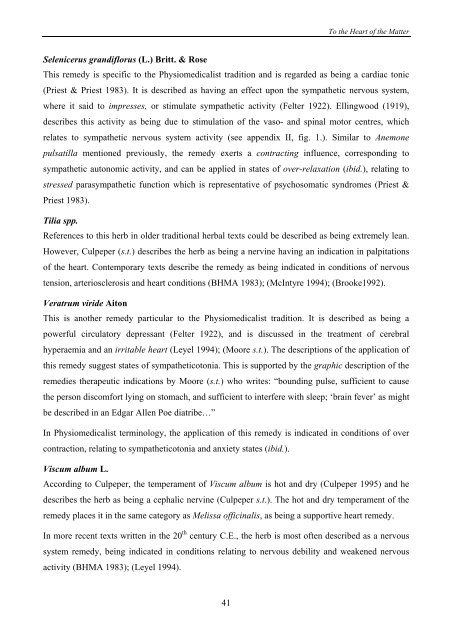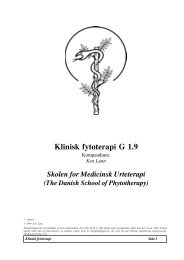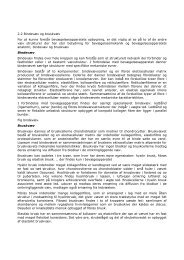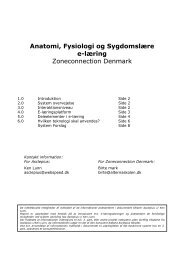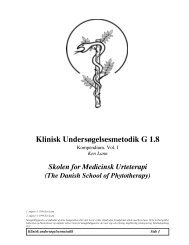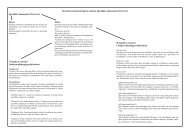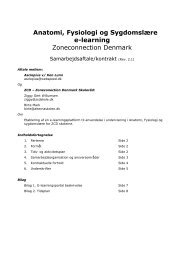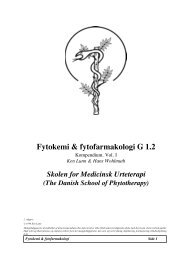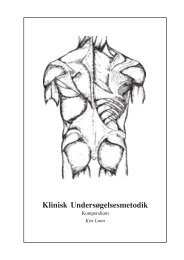PDF File - Asclepius Herbal Consultancy
PDF File - Asclepius Herbal Consultancy
PDF File - Asclepius Herbal Consultancy
Create successful ePaper yourself
Turn your PDF publications into a flip-book with our unique Google optimized e-Paper software.
Selenicerus grandiflorus (L.) Britt. & Rose<br />
To the Heart of the Matter<br />
This remedy is specific to the Physiomedicalist tradition and is regarded as being a cardiac tonic<br />
(Priest & Priest 1983). It is described as having an effect upon the sympathetic nervous system,<br />
where it said to impresses, or stimulate sympathetic activity (Felter 1922). Ellingwood (1919),<br />
describes this activity as being due to stimulation of the vaso- and spinal motor centres, which<br />
relates to sympathetic nervous system activity (see appendix II, fig. 1.). Similar to Anemone<br />
pulsatilla mentioned previously, the remedy exerts a contracting influence, corresponding to<br />
sympathetic autonomic activity, and can be applied in states of over-relaxation (ibid.), relating to<br />
stressed parasympathetic function which is representative of psychosomatic syndromes (Priest &<br />
Priest 1983).<br />
Tilia spp.<br />
References to this herb in older traditional herbal texts could be described as being extremely lean.<br />
However, Culpeper (s.t.) describes the herb as being a nervine having an indication in palpitations<br />
of the heart. Contemporary texts describe the remedy as being indicated in conditions of nervous<br />
tension, arteriosclerosis and heart conditions (BHMA 1983); (McIntyre 1994); (Brooke1992).<br />
Veratrum viride Aiton<br />
This is another remedy particular to the Physiomedicalist tradition. It is described as being a<br />
powerful circulatory depressant (Felter 1922), and is discussed in the treatment of cerebral<br />
hyperaemia and an irritable heart (Leyel 1994); (Moore s.t.). The descriptions of the application of<br />
this remedy suggest states of sympatheticotonia. This is supported by the graphic description of the<br />
remedies therapeutic indications by Moore (s.t.) who writes: “bounding pulse, sufficient to cause<br />
the person discomfort lying on stomach, and sufficient to interfere with sleep; ‘brain fever’ as might<br />
be described in an Edgar Allen Poe diatribe…”<br />
In Physiomedicalist terminology, the application of this remedy is indicated in conditions of over<br />
contraction, relating to sympatheticotonia and anxiety states (ibid.).<br />
Viscum album L.<br />
According to Culpeper, the temperament of Viscum album is hot and dry (Culpeper 1995) and he<br />
describes the herb as being a cephalic nervine (Culpeper s.t.). The hot and dry temperament of the<br />
remedy places it in the same category as Melissa officinalis, as being a supportive heart remedy.<br />
In more recent texts written in the 20 th century C.E., the herb is most often described as a nervous<br />
system remedy, being indicated in conditions relating to nervous debility and weakened nervous<br />
activity (BHMA 1983); (Leyel 1994).<br />
41


